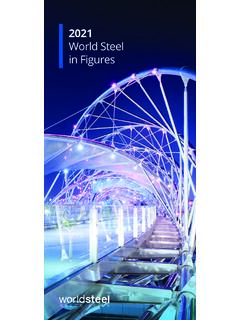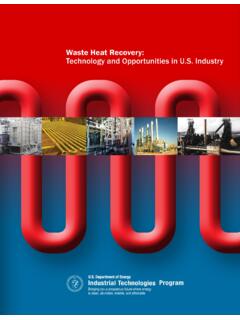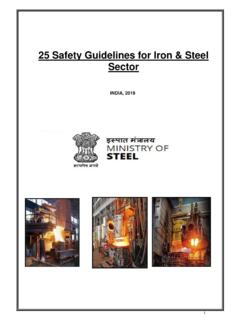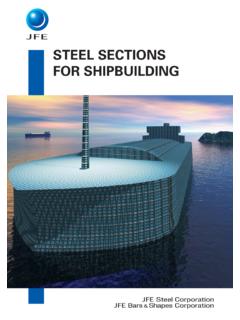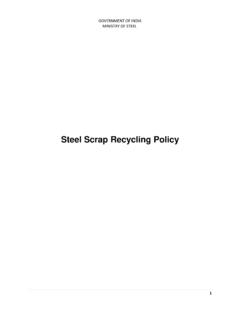Transcription of The Use of Hydrogen in the Iron and Steel Industry
1 DEPARTMENT OF ENERGY H2@SCALE WORKSHOPAUGUST 1, 2018 THE USE OF Hydrogen IN THE IRON AND Steel INDUSTRYP resented by Ed Green2 BERRY METAL COMPANY Over 65 years of experience Experience in EAF, BOF and Blast Furnaces ISO 9001:2008 Certified Over 75 Patents, several Pending Locations (Pittsburgh & Greater Chicago Area) Equipment Engineering and Manufacturing Company OEM Supplier of Components On-Site Technical Support Continuous Product ImprovementsSTEEL MAKING TECHNOLOGIES AND PROCESSES FOR IRON FEEDSTOCK BOF Basic Oxygen Furnace BF - Blast Furnace SR Smelting Reduction EAF Electric Arc Furnace Scrap Steel DRI Direct Reduced Iron3 THE USE OF Hydrogen IN THE IRON AND Steel INDUSTRYC hemical Processes to Reduce Iron Oxide Fe3O4+ H2= 3 FeO + H2O FeO+ H2= Fe + H2O Fe3O4+ CO= 3 FeO + CO2 FeO+ CO= Fe+ CO24 Reduction by COReduction by H2 THE USE OF Hydrogen IN THE IRON AND Steel INDUSTRYC onsumes 500 Nm3/tironof COConsumes 500 Nm3/tironof H2 BF/BOF -Blast Furnace
2 Feeding a Basic Oxygen Furnace has dominated the ironmaking process since the 1980s. Environmental regulations are causing a significant decline of the BF method of making iron. Although still the base source of virgin iron, new blast furnaces have not been built in the in decades and there are no plans to build one anytime soon. The Steel Industry is currently undergoing transformation. 5 THE USE OF Hydrogen IN THE IRON AND Steel INDUSTRYBLAST FURNACE EAF -Electric Arc Furnace for Steel making is a rapid growing technology competing with the BF/BOF Major feedstock is scrap Steel The purity of existing scrap Steel is declining and needs virgin iron added to dilute the tramp elements such as copper and zinc to improve final product quality DRI Direct Reduced Iron is one of the iron products added to the scrap to increase purity DRI is iron ore that has been reduced to iron with syngas without melting DRI processes in generally use natural gas to reduce the ore6 THE USE OF Hydrogen IN THE IRON AND Steel INDUSTRYELECTRIC ARC FURNACE
3 SCRAP & DIRECT REDUCED IRONTHE USE OF Hydrogen IN THE IRON AND Steel INDUSTRYM idrexReformer outside of reactorCreating syngas H2 & COHYL IIIP artial oxidation of gas entering reactorCreating syngas H2 & CODepictions taken from IETD Industrial Efficiency Technology DatabaseEstablished DRI Technology Competing with BF/BOFFLASH IRONMAKING TECHNOLOGY USING HYDROGENC urrent PartnersAmerican Iron and Steel Institute Department of Energy Berry Metal Company SteelUniversity of Utah8 THE USE OF Hydrogen IN THE IRON AND Steel INDUSTRYFlow Diagram for Flash Ironmaking PlantTHE USE OF Hydrogen IN THE IRON AND Steel INDUSTRYIron Ore InNatural Gas InIron OutAirAir In(for transferring heat)Air OutCooling WaterH2 StorageFe3O4+ 4H2= 3Fe + 4H2 OWhile Falling H2H2+ H2 OEnergy Usage for Ironmaking Comparison of Existing Reduction MethodsMethodEnergy GJ/tHYL GJ/tIron Carbide GJ/tData taken from IETD Industrial Efficiency Technology Database10 THE USE OF Hydrogen IN THE IRON AND Steel GJ/t is a conservative calculation based on maximum users during commercial scale operations.
4 Actuals could be IRONMAKING ENERGY BREAKDOWN GJ/tTHE USE OF Hydrogen IN THE IRON AND Steel INDUSTRY42%Natural Gas for Hydrogen24%Natural Gas for Fuel24%Reactor Electric Heating6%Exhaust Gas Recovery4%MiscEnergy Breakdown (GJ/t)THE USE OF Hydrogen IN THE IRON AND Steel INDUSTRYB last Furnace Operating temperature 250C @top to 1650C @bottomResidence time is 8 to 10 hrsDRI FurnaceOperating temperature1090C Residence time is 10 to 12 hrsFlash Ironmaking Furnace Operating temperature 1325 CResidence time is 2 to 10 secondsResidence time is a combination of speed of reaction due to temperature, size of the feed material and amount of excess gas/distance from equilibrium lineOPERATING ratio partial pressureTemperature CFe/FeOEquilibrium DiagramXX1325 Low temperatures CO more effective at reducing FeO High temperatures H2more effective at reducing FeOCO2/COH2O/H213 THE USE OF Hydrogen IN THE IRON AND Steel INDUSTRYDRI OperationalRangeFlash Iron Operational Rangereduce all FeOrequires 2X excess GJ/t to heat to 1325 CFeFeOWHY Hydrogen ?
5 Reduce all FeOrequires10X excess GJ/t to heat to 1325C










